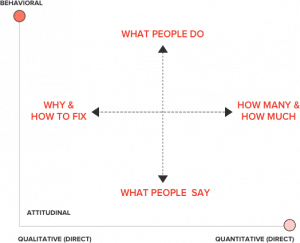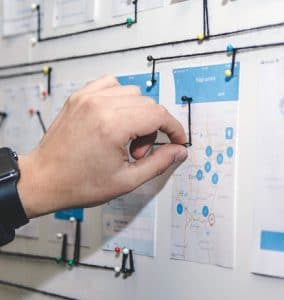Introduction:
Digital technologies are providing newer ways in which a customer can experience products and services. But as the number of digital touch points increases, customer experience is becoming increasingly complex.
Businesses need a strategy to ensure that they build the right experiences to meet their customers’ expectations and transform the organization to become a digital-savvy, customer-centered business.
In this ebook, we present a framework that guides you towards a strategy to access, measure, and optimize your Digital Experience, using industry standard tools and methods.
Why Invest in Digital Experience?

An effective digital experience:
• Engages customers
• Creates brand awareness
• Builds customer loyalty
• Boosts revenue
On the other hand, a bad digital experience:
• Brings down conversion rates
• Disengages customers
• Inflates development costs

Digital touchpoints help improve user experience because they are:
• Easier – People prefer when the steps to complete a goal are quick and easy, whether they’re consumers ordering a pizza or supply chain partners ordering parts online.
• More effective – It’s great to offer customers better ways to get things done with convenience.
• Emotionally aligned – It pays to foster loyalty by making customers feel valued and appreciated.
A Framework for Optimizing Digital Experience:

How can product and service designers create great digital experiences that are Easier, Effective and Emotionally aligned with the customer’s expectation?
• Explore
• Evaluate
• Experiment
• Engage
We have a created a four-point framework based on best practices. We call this framework 4 E’s of Optimizing Digital Experience –
Explore, Evaluate, Experiment, and Engage.
Explore – Use exploration methods for understanding the current state.
• Evaluate – Conduct usability testing of existing digital touch points to make sure systems work well for the people who use them.
• Experiment – Ideate and focus on making your ideas tangible through experimentation.
• Engage – Listen throughout the research and design cycle to understand existing problems and to look for new issues. Analyze the gathered data and monitor incoming information for patterns and trends.
Explore:

Understand The Current State.
The objective at this stage is to understand the current state by unveiling what you don’t know and better understanding what your customers need. It’s especially important to do exploratory activities before making a new product or feature, so you can find out whether it makes sense to do the project at all.
Explore Methods:

• Interview stakeholders to gather and understand business requirements and constraints.
• Interview sales and support staff: What are the most frequent problems and questions they hear from users? What are the worst problems people have? What makes people angry?
Explore Methods – Stakeholder Interviews
It is important to determine what content and functionality your digital touch points should deliver in order to match the customers’ needs, that also drive the business objectives. This should be done by:
• Interviewing key stakeholders
• Interviewing sales and support staff
Key Questions to Ask During Stakeholder Interviews:
• Who are our core customers?
• What is our brand promise?
• What is our current position in the market?
Explore Methods – Ecosystem Map

To know where you stand, you need to gauge your businesses underlying ecosystem by creating an ecosystem map — a diagram of the web of people, processes, and systems that support your customer’s digital journeys, regardless of whether they are inside or outside your company or its direct control.
Explore Methods – Interviews Sales and Support Staff
An enterprise sales team is often closer to the customers than the marketing team is. They may also be more focused on the here and now since they’re getting evaluated and compensated based on today’s sales, while the marketing group is more focused on the future. Good questions for salespeople often focus on what they hear from customers or see at customer sites:
Who is typically involved in the purchase decision?
• Why do customers buy a product like this one, and why this one over competitors?
• When you lose sales, what are the most common reasons?
• What things do customers complain about or ask for most often, and why?
Prioritize your Digital Touchpoints

Faced with an expanding array of options for providing digital interactions with customers, you need to prioritize the most important touch points (and platforms) they should invest in to reach their target users.
A simple prioritization matrix based on factors such as the benefit to the business, the benefit to users, and the number and importance of users affected can help determine the overall weighting of channels.
Evaluate:

Evaluate the Current experience.
To ensure that systems are working well for all those who use it, it is important to assess the quality of the experience that you’re delivering right now at key digital moments. By evaluating each design at each step on the way is how you assess it.
Aspects to Evaluate:
• Expert Evaluation: Evaluate digital touch points through heuristics methods.
• Competitive Testing: Find the strengths and weaknesses of your competitors’ products. Discover what users like best.
Explore Methods – Expert Evaluation

The very process of Expert Evaluation helps you recognize UX problems and offer practical recommendations. Expert evaluation should cover:
Presentation – How well is the user interface presented? This includes layouts, grids, white space, graphical elements, typography, and color palettes.
Interactions – What must users do to advance toward their goals? This includes in-page interactions (e.g., form interactions, controls, and response to users’ input) and multi-page interactions.
Evaluate Methods – Qualitative Usability Testing

Qualitative data offer a direct assessment of the usability of a system: researchers will observe the participants struggle with specific UI elements and infer which aspects of the design are problematic and which work well.
Then, based on their own UX knowledge and possibly on observing other participants encounter (or not) the same difficulty, researchers will determine whether the respective UI element is indeed poorly designed.
How to Evaluate – Quantitative Usability Testing

Quantitative data helps in conducting an indirect assessment of design usability.
This can be pertaining to users’ performance on a given task (e.g., task-completion time, success rate, error rate) or can signify the participants’ reaction to usability (for e.g., satisfaction ratings).
Experiment:

Using the output of the Explore and Evaluate phase(s) as a guide, brainstorm ways to solve the problem at hand or improve the digital experience – that’s Experimenting!
Experiment – Methods
• Explore design possibilities through paper prototypes by envisioning several distinct approaches, brainstorming, and testing the best ideas in order to land at the best-in-class components of design that must be retained.
• Use card sorting to find out how people group your information, to help inform your navigation and information organization scheme.
• Test interactive prototypes by watching people use them.
• Follow the co-creation approach to design. It involves customers (and/or stakeholders and employees) for analyzing problems and generating concepts to improve the design.
Experiment Methods – Paper Prototypes

• Make it tangible through quick and cheap low-fidelity prototypes. The prototypes can be done in a variety of way, ranging from pen-and-paper sketches to browser-based prototypes that are more interactive.
• Present the prototypes to real customers and employees for review and feedback. Reiterating this process of refining and testing helps one arrive quickly at an optimal solution.
Experiment Methods – Card Sorting

• Card Sorting is a qualitative and/or quantitative method wherein the users are instructed to organize items into groups and categorize each group.
• It helps in crafting or refining the site’s information architecture by unveiling users’ mental setups.
Engage:

• Continuously listen to your customers throughout the research, design, and implementation cycles to understand existing problems and to look for new issues.
• Analyze the gathered data and monitor incoming information for patterns and trends.
Engage Methods:

Here are some methods using which you can listen to your users:
• Survey your customers and prospective users.
• Track analytics and metrics to discover trends and anomalies and to gauge your progress.
• Analyze search logs to find what do people look for and what they call it. Search logs are often overlooked, but they contain important information.
• Analyze incoming feedback channels periodically for top usability issues and trouble areas. Look for clues about what people can’t find, their misunderstandings, and any unintended effects.
• Pay attention to user sentiment. Social media is a great place for monitoring user problems, successes, frustrations, and word-of-mouth advertising. Social media posts may be the first indication of a competitor’s emergence.
Engage Methods – Monitor Analytics and Metrics

Start with analytics, but don’t just stop there. Mine your analytics tools to find out where customers are going and what they’re doing on your digital touch points. New tools for behavior analysis provide further feedback through features like animated replays of real user journeys through your
site. Also, add texture to that data by sorting through the unsolicited (and unbelievably honest) feedback about customer experiences that come through emails, support calls, chat sessions, and social media posts.
Engage Methods – Collect Sample Insights User Experience Data at Multiple Levels:

Collect data about the User Experience at multiple levels and investigate pain points by connecting feedback with other data sources
Conclusion:
To elevate your digital experience while working within existing resource constraints, you may need to make hard choices about where to focus your efforts. And this decision-making doesn’t end when the improvement launches. Companies, that take an iterative approach to their mobile app development efforts. are well-positioned to react to customers’ feedback and usability results. Take testing, research, and feedback from your digital experience improvement project, and use it as the starting point for your next effort. What other areas can you improve? How will your customers benefit? Adopting this approach creates a cumulative effect where you consider the entire experience rather than engage in individual one-of projects. Hope our e-book has answered to all your queries pertaining to building mobile apps with great UX. To know more or to get in touch with our expert consultants.

